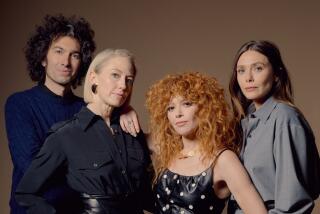Joyous and heartbreaking ‘Daughters’ reunites girls with their incarcerated dads

- Share via
Joyous and heartbreaking in equal measure, “Daughters” captures with alert sensitivity the lives of four girls whose fathers are incarcerated in a Washington, D.C., prison. Santana, Aubrey, Ja’Ana and Raziah — who were between 5 and 15 years old during the core events of the film — all are part of a program called Date With Dad. Launched in 2008 and run by the organization Girls for a Change, it reunites Black girls with their fathers, who have exchanged prison orange for suits and ties to participate in a kind of father-daughter prom.
Produced over five years, beginning in 2019, the film arose after Girls for a Change leader Angela Patton gave a 2012 TED Talk about the program, which originated in her hometown of Richmond, Va. Despite intense interest from filmmakers, she held off on offers until she heard from Natalie Rae, a Canadian music video director who was inspired by the story. “Natalie’s email was the only one that really centered the girls,” says Patton, who joined Rae in a recent Zoom conversation. “She definitely understood that it should be a collaborative effort. I thought, ‘Why not just give it a shot?’”

The film, available on Netflix, achieves a sometimes acute degree of intimacy as it maps a vivid spectrum of feelings before, during and after the reunions. Part of that is simply allowing the strong and endearing personalities to shine through the camera lens, but it’s also about the quiet dignity on display when no words are spoken.
Filmmakers overcame assault and lost equipment to finish ‘No Other Land,’ a documentary about the West Bank. But while it’s eligible for an Oscar, it still does not have U.S. distribution.
“They were brought into the idea that this could actually do the world some good, but it was also therapeutic for them,” says co-director Patton of the participants. “No one has asked them questions like this. No one usually cares about a family that is impacted by the horrible conditions and practices of the criminal justice system.”
Rae committed to a recurring cycle of visits to the girls and their families with a relaxed time frame. “We were not there to tell people what we wanted the film to be but really [to] just let life unfold,” she says. “Often we’d spend five hours having a chat. It’s not a 30-minute, 60-minute interview to try to get something. I think the girls feel that. Their confidence and openness keeps expanding. Our cinematographer had a parent that was incarcerated for seven or eight years when he was growing up. So every layer of the project had people that were authentic, that were open, that were funny, playful, had big, open hearts, and that made the difference.”

Rae cites as inspirations such documentaries as RaMell Ross’ “Hale County This Morning, This Evening,” which collapses years of Black life in west Alabama into 76 lyrical minutes, and Garrett Bradley’s “Time,” which makes powerful use of its subject’s home videos to chronicle her efforts to free her husband from a Louisiana prison.
“Daughters” was shot in multiple formats, including 16mm and Super 8 film, and on a digital Alexa and a budget-friendly Blackmagic Design camera. This accounts for a textural variety, but the considerations weren’t fully about aesthetics. “There were so many years where it was just us, paying for this and scraping together money to stay in D.C.,” Rae says. “We had to actually downscale to shooting on a Blackmagic, just a little tiny camera, because we didn’t have money for so many years to keep it going.”

Nonetheless, the film’s visual sensibility was guided by elemental factors inherent to the scenes, which so often pivot around movement and physical contact. “We were looking for ways that we’d follow a human touch in the moment with the camera,” Rae says. “Or the way that the camera could float between one scene and another, and kind of encapsulate some of the whimsical, imaginative qualities of the girls and the light that they carry. The whole dance itself is from the imagination of young girls. We wanted to allow the audience to feel the power of that mind-set.”
‘Dahomey’ and ‘Sugarcane,’ two acclaimed documentaries vying for Oscar recognition, tackle the legacies of colonialism.
Rae credits cinematographer Michael Cambio Fernandez for his empathetic approach. “He’ll sit on the floor for an hour with a little 1-year-old,” she says, “and try to understand what they’re looking at and get into their headspace.”
Patton looked to the work of filmmaker Ava DuVernay for artistic guidance. “She tells our historical stories and stories about what is possible for us in the future, and stories that are presented in a way where people can see the fact that we do exist, and that we have stories that are not the stereotypical stories that you may hear. I wanted it to be able to resonate with an audience that actually looked like me, that gets sick and tired of stories that are not representative.”
More to Read
From the Oscars to the Emmys.
Get the Envelope newsletter for exclusive awards season coverage, behind-the-scenes stories from the Envelope podcast and columnist Glenn Whipp’s must-read analysis.
You may occasionally receive promotional content from the Los Angeles Times.










